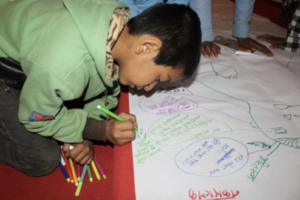Suggested age: 4+

This tool is most effective when used by a group of children that are similar in age, background and gender. Children draw around the body shape of one of their friends to use the ‘body map’ shape to identify issues that are affecting them through the senses (see, hear, smell, touch, feel). This can help children to think more personally about these issues, feelings, and experiences: their likes, dislikes, rights, needs in order to be healthy, etc.
To ensure the correct use of the body map, the facilitator needs to be sensitive to diverse socio-cultural religious contexts and understand the children’s cultural and religious beliefs.
For example, the body mapping tool was used by the APC (Access to Play in Crisis) research in Nepal with children displaced by the Gorkha earthquake, to record their experiences. Children expressed their feelings, spoke about the crisis, their coping mechanisms, their physical environments and their spaces of play and socialisation (IPA, 2017).
See Bernard van Leer Foundation’s report ‘Steps for engaging young children in research’ (p.115-118) to learn more about this tool.
Body Mapping can help address the following questions:
- What are the issues affecting the children?
- How do they experience the spaces around them through their senses: hearing, seeing, touching?
- Where do they feel safe/unsafe and why?
- Where do they go in the neighbourhood?
